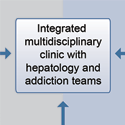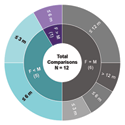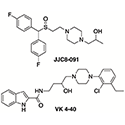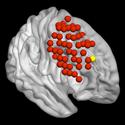Reviews To Read – February 2022. Published in Lancet Gastroenterology and Hepatology and Coauthored by Lorenzo Leggio of the NIDA IRP Clinical Psychoneuroendocrinology and Neuropsychopharmacology Section. Despite its increased recognition as a major public health issue, alcohol use disorder is mostly underdiagnosed and undertreated. The undertreatment and underdiagnosis of alcohol use disorder is most concerning… [Read More]
News Main
Gut microbiome and metabolome in a non-human primate model of chronic excessive alcohol drinking.
Featured Paper of the Month – February 2022
Published in Translational Psychiatry by Daria Piacentino and Lorenzo Leggio, et al. of the NIDA IRP Clinical Psychoneuroendocrinology and Neuropsychopharmacology Section.
Chronic excessive alcohol drinking causes more than 80,000 deaths in the U.S. each year. The gut microbiota, which hosts more than a trillion bacteria, is gaining increasing attention as a potential modulator in neuropsychiatric disorders. Its diversity is fundamental in maintaining homeostasis. There is limited research on the role of the microbiome-gut-brain axis in alcohol use disorder. Dr. Daria Piacentino and her colleagues address the fundamental question on whether chronic excessive alcohol drinking affects the gut microbiome and metabolome in a baboon model, investigated under rigorous controlled experimental conditions…
Sex differences in opioid and psychostimulant craving and relapse: a critical review.
Reviews To Read – January 18, 2022. This systematic review summarizes clinical and preclinical studies on sex differences in psychostimulant and opioid craving and relapse. The results of the clinical studies reviewed do not appear to support the notion that women are more vulnerable to psychostimulant and opioid craving and relapse. The results of the… [Read More]
Synaptic Zn2+ potentiates the effects of cocaine on striatal dopamine neurotransmission and behavior
Featured Paper of the Month – January 2022
Published in Translational Psychiatry by Juan Gomez and Michael Michaelides of the NIDA IRP Biobehavioral Imaging and Molecular Neuropsychopharmacology Unit.
Cocaine binds to the dopamine (DA) transporter (DAT) to regulate cocaine reward and seeking behavior. Zinc also binds to the DAT, but the in vivo relevance of this interaction is unknown. We examined this interaction by altering zinc availability and measuring behavior and physiology associated with cocaine exposure. To alter zinc levels, we manipulated dietary zinc or used a mouse model that lacked the zinc transporter ZnT3. The body has no storage system for zinc and one must consistently replenish this essential element via zinc-rich food sources. Of the 24 transporters dedicated to moving zinc around the body, ZnT3 is necessary to shuttle zinc around the brain…
Detailed mapping of behavior reveals the formation of prelimbic neural ensembles across operant learning
Hot Off the Press – January 3, 2022 Published in Neuron by Yan Zhang, Alex Denman, and Da-Ting Lin, et al. of the NIDA IRP Neural Engineering Section. Zhang and Denman et al developed deep behavior mapping (DBM), a self-supervised learning method for fine-grained analysis of behavioral micro-states in video data. They combined DBM with… [Read More]
New Drugs, Old Targets: Tweaking the Dopamine System to Treat Psychostimulant Use Disorders
Reviews To Read – December 2021. Published in Annual Review of Pharmacology and Toxicology by Amy Hauck Newman, et al. The use of illicit psychostimulants, such as cocaine and methamphetamine, continues to pose significant health and societal challenges. Despite considerable efforts to develop medications to treat psychostimulant use disorders, none have proven effective, leaving an… [Read More]
Waving through the window: a model of volitional social interaction in female mice
Hot Off the Press – December 21, 2021 Published in Biological Psychiatry by Leslie Ramsey, et al. In this study we introduce a model of volitional social learning and choice in female mice. We systematically compare two widely used mouse strains at two different developmental stages: adolescent and adult C57BL/6 mice and outbred CD1 mice. Unexpectedly,… [Read More]
Hypothalamic control of interoceptive hunger
Featured Paper of the Month – December 2021
Published in Current Biology by Justin Siemian, Sarah Sarsfield, Yeka Aponte of the NIDA IRP Neuronal Circuits and Behavior Unit.
Regulating food intake is essential for survival and many factors influence feeding behaviors beyond caloric need or “hunger”. Despite this, some neurons that drive feeding in mice are routinely referred to as ‘‘hunger neurons,’ whereas others are not. To understand how specific hypothalamic neurons control interoceptive hunger, we trained mice to discriminate feelings of “hunger” from satiety. We then used optogenetics to manipulate the activity of three hypothalamic neuronal populations with well-known effects on feeding while mice performed this behavioral task…
Orbitofrontal cortex and dorsal striatum functional connectivity predicts incubation of opioid craving after voluntary abstinence
Hot Off the Press – November 5, 2021 We recently introduced a rat model of incubation (time-dependent increase) of oxycodone craving after voluntary abstinence induced by negative consequences of drug seeking. We used resting-state functional MRI to determine whether longitudinal functional connectivity changes in orbitofrontal cortex (OFC) circuits would predict incubation of oxycodone seeking after… [Read More]
Functional connectivity of dorsolateral prefrontal cortex predicts cocaine relapse: implications for neuromodulation treatment
Featured Paper of the Month – November 2021
Published in Brain Communications by Tianye Zhai and Yihong Yang et al. in the NIDA IRP Magnetic Resonance Imaging and Spectroscopy Section.
Cocaine use disorder is a highly relapsing chronic brain disease with current treatments relatively ineffective. Finding brain areas and brain functional circuits that are relevant to cocaine relapse is crucial in understanding the brain mechanisms of addiction as well as in developing effective treatment protocols. By combining the resting-state fMRI and the Cox regression based predictive modeling, Zhai et al. identified three sets of dorsolateral prefrontal cortex (dlPFC)-centric functional circuits that predict cocaine relapse with high accuracy, provide insights into the multiple roles ofthe dlPFC in brain functioning that affect treatment outcome, and suggest these dlPFC loci as potential neuromodulation targets for addiction treatment…










